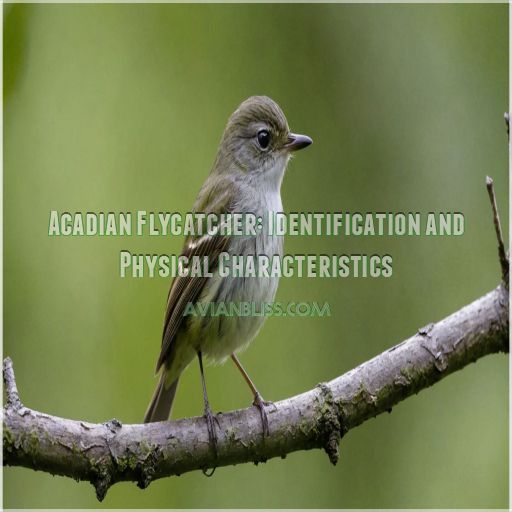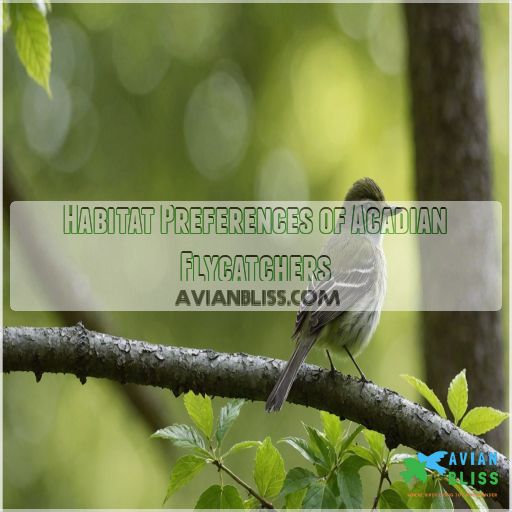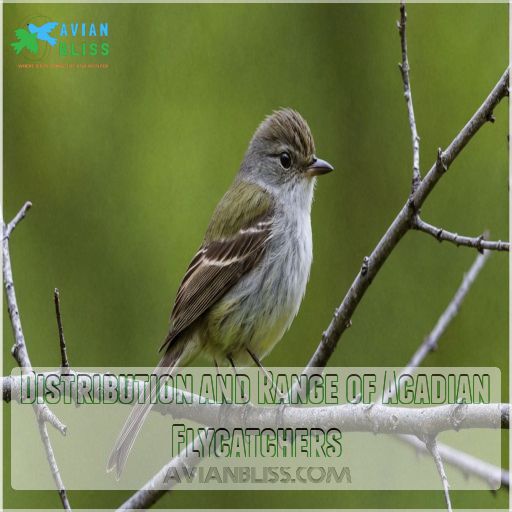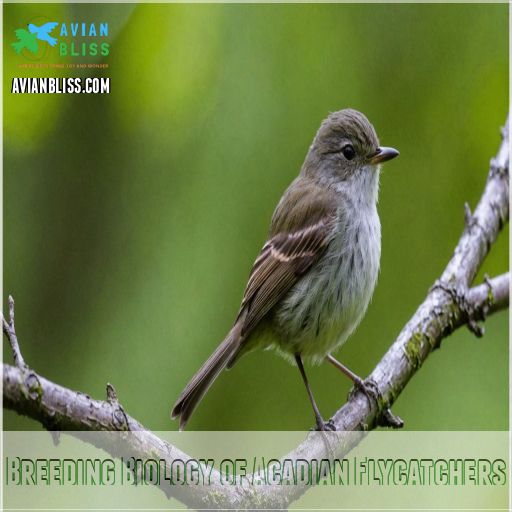This site is supported by our readers. We may earn a commission, at no cost to you, if you purchase through links.
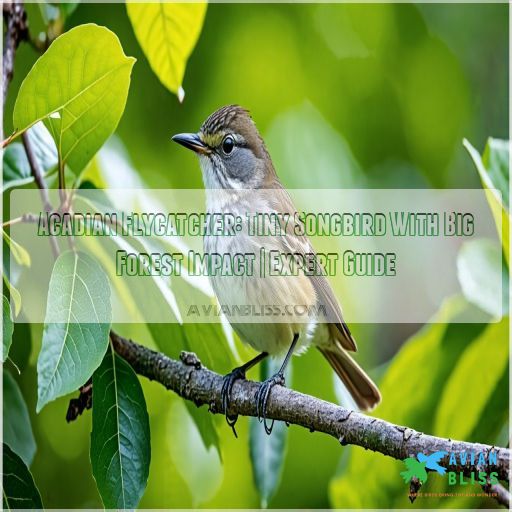
They’re picky about their digs, preferring mature deciduous forests near water. Come winter, these tiny travelers jet off to Central and South America.
They’re fierce defenders of their turf, engaging in aerial battles that’d put Top Gun to shame.
But there’s more to these feathered friends than meets the eye – their nesting habits and conservation needs paint a fascinating picture of life in our changing forests, highlighting the importance of understanding their conservation needs, especially among woodpeckers in new hampshire woodpeckers in nh
.
Table Of Contents
- Key Takeaways
- Acadian Flycatcher: Identification and Physical Characteristics
- Habitat Preferences of Acadian Flycatchers
- Distribution and Range of Acadian Flycatchers
- Acadian Flycatcher Behavior and Ecology
- Breeding Biology of Acadian Flycatchers
- Conservation Status and Threats
- Acadian Flycatcher Research and Monitoring
- Frequently Asked Questions (FAQs)
- Where are acadian flycatchers found?
- What are some fun facts about the Acadian Flycatcher?
- What is the difference between Acadian and least Flycatcher?
- Do acadian flycatchers migrate?
- How long do Acadian Flycatchers typically live?
- What are the main predators of Acadian Flycatchers?
- Do Acadian Flycatchers form flocks during migration?
- How do climate changes affect Acadian Flycatcher populations?
- What unique adaptations help Acadian Flycatchers catch insects?
- Conclusion
Key Takeaways
- You can recognize the Acadian flycatcher by its olive-green plumage and sharp "peet-sah" call, which echoes through mature deciduous forests near water, where it snatches insects mid-flight like a skilled acrobat.
- These small songbirds are picky about their habitat, favoring large, undisturbed woodlands, and they are not shy to defend their territory with aerial battles that could rival a Top Gun scene.
- Their long-distance migration to Central and South America each winter is crucial for survival, and they need strategic stopover sites filled with bugs to refuel, highlighting the importance of maintaining connected habitats.
- Climate change and habitat loss require conservation efforts to safeguard their future, making them like canaries in a coal mine, signaling broader ecosystem changes and reminding us that every effort counts in preserving their forest homes
.
Acadian Flycatcher: Identification and Physical Characteristics
You’ll spot the Acadian Flycatcher by its olive upperparts, whitish underparts, and distinctive white eye ring.
Its unique "ka-zeep" song and preference for midstory perches in mature forests near water make this small insectivore stand out among its flycatcher relatives.
Size and Coloration
A tiny titan of the forest, the Acadian Flycatcher measures just 5.5-5.9 inches long with a wingspan of 8.7-9.1 inches. You’ll spot this small-bodied bird by its olive upperparts and whitish underparts.
Its plumage adapts to its environment, with juveniles sporting a more brownish hue.
- Weighs a mere 0.4-0.5 ounces
- Larger than Yellow Warblers, smaller than Great Crested Flycatchers
- Distinctive yellowish belly and buffy wing bars
- Seasonal changes affect plumage, with molt patterns varying by age
Distinctive Features
While the Acadian flycatcher’s olive-green plumage might blend in with the forest, you’ll spot its standout features if you look closely. A thin white eye ring and bold wing bars set it apart from other small songbirds.
Its triangular head and uniquely shaped bill are telltale signs you’re observing this insect-eating marvel . One notable feature of the Acadian flycatcher’s bill is its similarity to birds with long beak adaptations, which allow for precision feeding and versatility in catching prey.
Although not as long as some species, the Acadian flycatcher’s bill is essential in aiding its insect capture abilities.
| Feature | Description | Significance |
|---|---|---|
| Eye ring | Thin, white | Key identifier |
| Wing bars | Bold, white to buff | Distinguishes from similar species |
| Bill | Black upper, yellow-pink lower | Aids in insect capture |
| Head shape | Triangular | Distinctive profile |
Song and Vocalizations
You’ll hear the Acadian Flycatcher’s distinctive song during breeding season. Its sharp, explosive "peet-sah" call rings through the forest. Listen for variations in song patterns and territorial calls as males establish their domains through complex vocal communication methods like birds’ vocal signals
.
Their acoustic communication plays a key role in mate attraction and defending territory against rivals, including potential brood parasites like the brown-headed cowbird.
These tiny songbirds also produce excited trills and twitters, showcasing their vocal range.
Comparison to Similar Species
Distinguishing the Acadian Flycatcher from its lookalikes can be tricky, but you’ve got this! It’s one of the largest Empidonax flycatchers, with a peaked head and long wings. The olive upper parts, yellowish underside, and two pale wingbars are shared features, but the Acadian’s thin white eyering sets it apart.
- A forest whisper in the leaves
- Nature’s hidden gem, waiting to be discovered
- A challenge that sharpens your birding skills
- The thrill of spotting this elusive woodland dweller
Habitat Preferences of Acadian Flycatchers
You’ll find Acadian Flycatchers in mature, undisturbed forests near water bodies like streams and river bottoms.
These small songbirds prefer large woodlots with a dense canopy and open understory, making them sensitive to forest fragmentation.
Breeding Habitat Requirements
Acadian Flycatchers have specific breeding habitat requirements that shape their nesting success. These small songbirds prefer large, mature deciduous forests with closed canopies and relatively open understories . You’ll find them in moist woodlands, often near streams or in ravines.
Let’s explore their habitat preferences:
| Feature | Preference | Importance |
|---|---|---|
| Forest Type | Deciduous | High |
| Canopy | Closed | Critical |
| Understory | Open | Moderate |
| Moisture | High | Significant |
| Size | Large tracts | Essential |
Understanding these requirements helps conservation efforts and maintains healthy avian communities.
Wintering Grounds
When winter hits, these tiny forest dwellers head south for a change of scenery.
They’re on a tropical vacation of sorts, but instead of relaxing, they’re busy catching bugs.
You’ll find Acadian Flycatchers nestled in the lowland forests of Central America and northern South America. They’re not picky about the age or rainfall of these forests, but they do turn their beaks up at open spaces.
It’s all about finding the right environment, with lowland forests being the perfect place to call home during the winter months. And with more bug-catching and less sunbathing, they make the most of their time in these new surroundings.
Migration Stopover Sites
Imagine you’re a tiny Acadian Flycatcher, flitting from branch to branch during your epic migration journey. You’ll need to make strategic pit stops along the way. These migration stopover sites are vital for your survival and success.
Here’s what you should look for:
- Forested areas with plenty of insects for refueling
- Safe havens away from predators and disturbances
- Diverse habitats that offer both shelter and food resources
Remember, your stopover choices can make or break your migration. Choose wisely!
Forest Structure and Composition
The forest structure that Acadian Flycatchers call home is like a carefully crafted masterpiece.
They’re picky neighbors, preferring large, intact woodlands with minimal fragmentation, and mature, closed-canopy deciduous forests with an open understory.
Canopy density and deadwood presence play key roles in their habitat selection.
Your stewardship responsibilities include maintaining forest connectivity to support their 1-2 broods, which develop over 13-14 days.
Distribution and Range of Acadian Flycatchers
You’ll find Acadian Flycatchers breeding across the eastern United States and southwestern Ontario, favoring mature deciduous forests near water bodies.
During winter, these long-distance migrants travel to southern Central America and northwestern South America, inhabiting tropical forest understories.
Breeding Range in North America
Acadian Flycatchers stretch their wings across eastern North America during breeding season. You’ll find these excellent fliers in deciduous forests from southern Canada to the Gulf Coast, with their core range in the eastern United States. They’re area-sensitive, preferring large, undisturbed woodlands near streams, similar to the dense understory of boreal forests preferred by the Canada Warblers in understory.
Like the Canada Warbler, they’re also vulnerable to habitat loss, which is shifting their distribution northward, impacting population trends.
Climate change and habitat loss are shifting their distribution northward, impacting population trends.
Conservation efforts focus on preserving mature New York woodpeckers to protect these small beetle hunters and their 13-15 day nesting cycle
.
Wintering Range in Central and South America
While you’re enjoying summer in North America, these tiny travelers are gearing up for a long journey.
Come winter, you’ll find Acadian Flycatchers (Empidonax virescens) in Central and South America .
They’re picky about their winter digs, preferring undisturbed mature forests with lush understory thickets.
It’s like they’re trading one leafy paradise for another, maintaining their love for dense canopies and rich ecosystems across continents.
Migration Routes
As summer fades, you’ll witness these petite travelers setting out on their grand journey.
Acadian flycatchers, middle-distance migrants, wing their way from U.S. breeding grounds to southern Central and northern South America.
They’re not just fair-weather friends; these tiny adventurers show loyalty to their territories during migration and possibly even in winter.
Keep an eye out for them near streams or wetland openings, where they’ll grab a quick bug snack before continuing their epic trek.
Historical Range Changes
Over time, you’d notice significant shifts in where Acadian Flycatchers call home. Their historical range has undergone a rollercoaster ride due to human influence and climate impact.
Here’s what you’d see:
- Range contraction in northern edges
- Population decline in fragmented forests
- Expansion into new areas with suitable habitat
These changes paint a picture of a species adapting to our evolving landscape. You’re witnessing nature’s delicate dance, with these tiny songbirds as the reluctant performers.
Acadian Flycatcher Behavior and Ecology
You’ll find the Acadian Flycatcher’s behavior fascinating, from its expert insect-catching techniques to its territorial nature.
These small songbirds exhibit unique daily patterns and interactions with other species, offering a glimpse into the complex ecosystem of mature forests.
Foraging Techniques and Diet
The Acadian Flycatcher’s foraging techniques are a masterclass in aerial acrobatics.
You’ll find these tiny hunters perched midstory, eyes peeled for their next meal. With lightning-fast reflexes, they dart out to snatch insects from the undersides of leaves or pluck them right out of the air. It’s like watching a high-stakes game of hide-and-seek, where the prize is a juicy bug.
| Foraging Behavior | Prey Type | Emotional Impact |
|---|---|---|
| Hawking | Flying insects | Awe-inspiring |
| Gleaning | Leaf-dwelling insects | Precise |
| Hovering | Hard-to-reach prey | Mesmerizing |
| Diving | Aquatic insects | Daring |
| Seasonal adaptation | Varied diet | Resilient |
Territorial Behavior
You’ve seen how Acadian Flycatchers hunt for food, but their territorial behavior is equally fascinating.
These tiny songbirds are fierce defenders of their turf.
Males aggressively protect larger-than-necessary territories, possibly preparing for food shortages or predator increases (Source).
They use song variation to mark boundaries and engage in fierce aerial chases during disputes.
Nest defense is no joke – they’ll even attack larger birds to keep their young safe.
They exhibit fierce aerial chases during disputes.
Daily Activity Patterns
Shifting gears from territorial antics, let’s explore the Acadian Flycatcher’s daily routine.
These early birds kick off their day before dawn, belting out songs as the sun rises. You’ll find them busiest in the morning, scanning for insects and foraging with precision.
As the day progresses, they mix up their activities – flying, resting, and preening.
Come evening, they’ll treat you to another serenade before settling in for the night.
Interactions With Other Species
Acadian Flycatchers navigate a complex web of interactions in their forest homes.
You’ll find these tiny songbirds engaging in:
- Intense territorial disputes with neighboring flycatchers
- Clever predator avoidance tactics to protect their nests
- Unexpected foraging associations with other species
They’re not immune to brood parasitism, though they’ve developed strategies to combat it.
Interspecific competition for food and nesting sites keeps them on their toes. Despite their size, these plucky birds hold their own in the forest ecosystem.
Breeding Biology of Acadian Flycatchers
You’ll discover the intricacies of Acadian Flycatcher reproduction, from courtship to fledging. Their breeding biology showcases adaptations to forest ecosystems, influencing conservation strategies for this small yet significant songbird.
Courtship and Pair Formation
The breeding season sparks a flurry of activity for these tiny forest dwellers.
Male Acadian Flycatchers arrive first, staking out prime territories with their distinctive "peet-sa" calls.
When females join the scene, courtship displays begin. Males perform aerial acrobatics, showcasing their agility and fitness.
Mate selection hinges on territory quality and the male’s vigor.
Once paired, these birds form monogamous bonds, working together to establish their nesting grounds.
Nest Construction and Placement
Skilled architects, female Acadian Flycatchers craft their nests with precision.
You’ll find these avian homes nestled in horizontal forks, typically 10-30 meters high. They’re woven from spiderwebs, cocoon silk, and plant fibers, creating a snug hammock.
The birds’ nest site selection is vital for success, balancing safety from predators with accessibility.
You’d be amazed by the streamers dangling below, a unique touch that might just be nature’s version of home decor.
Egg Laying and Incubation
Female Acadian Flycatchers lay a clutch of 3 eggs, though you might occasionally spot 2 or 4 in a nest.
The eggs are creamy white with light brown spots, a perfect camouflage in their forest homes.
Mom’s got her work cut out for her during the 13-15 day incubation period, as she’s solely responsible for keeping those eggs warm.
It’s a delicate balance between nest site selection and avoiding predation in these woodland nurseries.
Nestling Care and Development
Once eggs hatch, you’ll witness an incredible transformation. Acadian Flycatcher parents tirelessly care for their nestlings, ensuring rapid growth and development. Both mom and dad take turns feeding their hungry brood, bringing a smorgasbord of insects to fuel their offspring’s growth.
Here’s what you might observe during this key period:
- Nestling growth rates accelerate dramatically
- Parents vigilantly guard against brood parasitism
- Frequent parental feeding boosts nestling survival
- Fledgling success hinges on attentive care
Conservation Status and Threats
You’ll find the Acadian Flycatcher’s conservation status intriguing, as it faces both challenges and hope.
While habitat loss threatens this tiny songbird, ongoing efforts aim to protect its forest home.
These efforts also aim to guarantee its survival for future generations to enjoy.
Population Trends and Estimates
Several surveys paint a complex picture of Acadian Flycatcher populations. You’ll find they’ve remained relatively stable between 1966 and 2015. Partners in Flight estimates a global population of 5.2 million birds.
Let’s break down the data:
| Region | Population Trend | Conservation Status |
|---|---|---|
| North America | Stable | Low Concern |
| Canada | Declining | Endangered |
| Wisconsin | Inconclusive | Threatened |
Despite overall stability, localized declines highlight the need for targeted conservation efforts. You’re part of their story – your awareness can make a difference.
Habitat Loss and Fragmentation
Two major threats loom over Acadian Flycatchers: habitat loss and forest fragmentation.
These issues lead to lower reproductive success and increased brood parasitism by Brown-headed Cowbirds.
You’ll find these tiny songbirds struggling to thrive in smaller woodlots, as they prefer large, undisturbed mature forests.
Conservation strategies focus on preserving extensive forest tracts and restoring fragmented habitats to maintain healthy population dynamics.
It’s a delicate balance, but with your support, we can help these forest indicators flourish.
Climate Change Impacts
Climate change’s invisible hand is reshaping the Acadian Flycatcher’s world.
You’ll notice shifts in their migration patterns and breeding seasons as temperatures rise. Their forest homes are transforming, with some areas becoming less suitable while others open up.
Food availability fluctuates, challenging these tiny hunters.
Like canaries in a coal mine, these flycatchers signal broader ecosystem changes. Their adaptability to warming temperatures may vary among populations, highlighting the complex nature of climate impacts on wildlife.
Conservation Efforts and Strategies
Conservationists are rallying to protect the Acadian Flycatcher. You can join the effort by supporting habitat restoration and forest management initiatives.
These tiny birds need your help to thrive. Experts use population monitoring to track their numbers, while community engagement spreads awareness.
Some organizations even explore captive breeding as a last resort. By working together, we’re giving these feathered friends a fighting chance in their forest homes , through methods like population monitoring.
Acadian Flycatcher Research and Monitoring
You’ll find ongoing research efforts focused on the Acadian Flycatcher’s population dynamics, habitat preferences, and migratory patterns.
These studies employ various techniques, including population surveys, habitat use analyses, migration tracking, and genetic assessments, to inform conservation strategies for this forest-dwelling songbird.
Population Surveys and Tracking
Monitoring Acadian Flycatcher populations is a team effort.
You can join scientists in tracking these forest dwellers using:
- Citizen science platforms like eBird
- Annual breeding bird surveys
- Advanced tracking technologies
These methods help researchers understand population trends and migration patterns. Data analysis reveals valuable insights into the flycatcher’s life cycle.
By participating in surveys, you’re not just counting birds—you’re contributing to a broader understanding of forest ecosystems and helping protect the Acadian Flycatcher’s future.
Habitat Use Studies
In the thick of the forest, you’ll find researchers digging deep into Acadian Flycatcher habitat use.
They’re tracking how these tiny birds choose their homes, considering factors like forest structure and fragmentation.
You’d be surprised how picky these flycatchers can be!
Their nest site choices reveal a lot about forest health.
Scientists use this info to guide habitat restoration efforts, ensuring these feathered friends have cozy spots to raise their families.
Migration and Wintering Ecology Research
Understanding the Acadian Flycatcher’s journey isn’t just for the birds—it’s a window into our changing world.
You’ll find researchers tracking migration timing and stopover site selection, uncovering the mysteries of these tiny travelers.
They’re also studying wintering habitat fidelity and range expansion, shedding light on how climate change impacts these feathered friends.
It’s like piecing together a global puzzle, with each discovery bringing us closer to safeguarding their future.
Conservation Genetics and Management
Delving into the genetic makeup of Acadian Flycatchers reveals important insights for their conservation.
You’ll find that researchers are studying genetic diversity to understand population dynamics and habitat connectivity, similar to the habitat preferences of Least Flycatchers, which often inhabit deciduous or mixed forests.
They’re using this data to guide captive breeding programs and inform conservation partnerships. By examining DNA, scientists can track family lines and identify at-risk populations, helping to make sure these tiny songbirds continue to play their big role in forest ecosystems.
They face threats such as habitat loss and climate change.
Frequently Asked Questions (FAQs)
Where are acadian flycatchers found?
Did you know 2 million Acadian Flycatchers call North America home?
You’ll spot these feathered friends in mature deciduous forests, often near streams or ravines.
They’re partial to the eastern U.S., from Minnesota to Texas, and east to the Atlantic Coast.
What are some fun facts about the Acadian Flycatcher?
You’ll love these Acadian Flycatcher tidbits! They’re excellent fliers, maneuvering backward and hovering with ease.
Their explosive "ka-zeep" song makes them easy to detect.
Surprisingly, they’re no longer found in Acadia, despite their name.
What is the difference between Acadian and least Flycatcher?
These feathered friends may look alike, but they’re not two peas in a pod.
You’ll spot Acadians by their larger size, flatter foreheads, and yellowish undersides.
Leasts are compact with bold white eye-rings and congregate in clusters.
Do acadian flycatchers migrate?
Absolutely, these small songbirds set off on impressive journeys.
You’ll find them flying south across Mexico and the Caribbean each winter, settling in Colombia, Ecuador, and Venezuela.
They return north for breeding, often at night.
How long do Acadian Flycatchers typically live?
Like a tiny forest sentinel, these birds endure.
You’ll find they typically live about 10 years and 9 months in the wild.
The longest recorded lifespan was an impressive 10 years and 11 months (Source).
That’s remarkably long for small avians.
What are the main predators of Acadian Flycatchers?
You’ll find hawks, owls, and snakes stalking these birds.
Crows, jays, and squirrels raid their nests. Even cats pose a threat.
It’s a jungle out there for these feathered friends, constantly on high alert.
Do Acadian Flycatchers form flocks during migration?
During migration, Acadian Flycatchers don’t typically form large flocks.
They’re solitary birds that travel individually or in small groups.
You’ll find them stopping over in moist woodlands, fueling up for their journey to wintering grounds.
How do climate changes affect Acadian Flycatcher populations?
Warming temperatures threaten thriving populations, while stable climates nurture growth.
You’ll see fewer fledglings as heat rises, increasing nest predation.
Severe scenarios risk local extinction, but milder changes maintain delicate balance between resilience and vulnerability.
What unique adaptations help Acadian Flycatchers catch insects?
Flycatchers possess remarkable adaptations for insect capture.
Their short legs and three forward-facing toes enable perching on thin branches.
With flattened bills and bristles, they snag prey mid-flight, employing "hawking" techniques from high perches (Source).
Their aerial agility is unmatched.
Conclusion
Acadian flycatchers, those aerial acrobats of the forest, fascinate with their finesse and fortitude.
You’ve now got the inside scoop on these tiny titans, from their olive-green plumage to their pivotal role in forest ecosystems.
As you explore eastern woodlands, keep your eyes and ears peeled for the Acadian flycatcher’s distinctive "peet-sah" call.
By understanding their needs and challenges, you’re equipped to appreciate and protect these remarkable birds.
Remember, every forest walk is a chance to connect with nature’s high-flying heroes and to explore the eastern woodlands.

